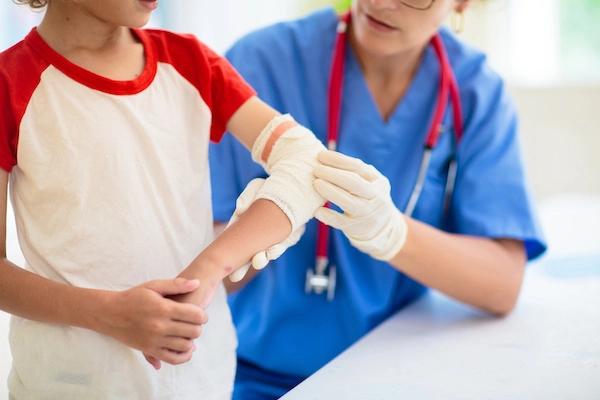The Critical Differences Between Sprains and Fractures
When it comes to kids’ injuries, it is important to distinguish between a sprain and a fracture. A sprain occurs when ligaments, which connect bones at a joint, are stretched or torn, often from a sudden twist, fall, or impact. Symptoms include tenderness, swelling, bruising, and limited movement.
A fracture, or broken bone, is a partial or complete break in the bone. While symptoms can overlap with a sprain, fractures may cause sharper pain, visible deformity, inability to bear weight, or, in severe cases, bone protruding through the skin. Some fractures, such as stress fractures, develop gradually from repetitive motion, while others result from sudden trauma.
5 Red Flags That Suggest a Fracture
While many sprains heal with rest and support, certain signs may indicate a more serious injury. Severe pain that worsens with movement is a common warning sign, as is any obvious deformity or misalignment in the injured area. Swelling and bruising that do not improve with rest, ice, compression, and elevation (R.I.C.E.) should also raise concern. If your child cannot bear weight or use the injured part of their body, it may indicate a fracture. Finally, open wounds or a bone protruding through the skin require immediate emergency care. Recognizing these red flags early helps ensure your child receives the prompt treatment needed for proper healing.
How Pediatric Orthopedic Specialists Diagnose Injuries
If a fracture is suspected, diagnosis begins with a thorough evaluation of the injured area and the child’s medical history. Specialists assess pain, range of motion, and the ability to move the limb. When a fracture is not immediately visible, imaging tests such as X-rays help confirm the presence and type of break. Pediatric orthopedists are specially trained to understand the growth and healing patterns of children’s bones, ensuring injuries are properly diagnosed and treated for the best outcome.
Why Children’s Bones Break Differently Than Adults’
Children’s bones are more flexible and resilient than adult bones due to their growth plates and softer structure. This means fractures may occur differently, sometimes bending or cracking rather than breaking completely. Younger children are more prone to overuse injuries, while older children may experience more acute fractures from sports or falls. Understanding these differences helps guide appropriate treatment and supports proper healing.
Treatment Options: From Rest to Casting
Treatment depends on whether the injury is a sprain or a fracture. Minor sprains are often managed with R.I.C.E. and an elastic bandage for support. Fractures typically require immobilization with a splint or cast to allow the bone to heal correctly. In some cases, crutches or slings may be needed to reduce stress on the injured area. Severe or displaced fractures may require surgery to realign the bones, though most pediatric fractures heal well without surgical intervention thanks to children’s strong natural healing response.
Get Expert Injury Evaluation
If your child shows signs of persistent pain, swelling, or limited use of an injured area, it is important to seek evaluation from a pediatric orthopedic specialist. While minor injuries can often be treated at home, more serious injuries may require urgent care or an emergency room visit. Pediatric specialists provide comprehensive care, from diagnosis to treatment and guidance on returning safely to activities. With prompt attention and the right care, most kids recover quickly and get back to the sports, play, and adventures they love.



